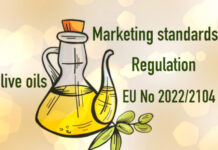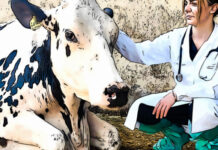Reg. EU 2022/2105, effective 25.11.22, introduces new rules on conformity checks of olive oils. (1) In a logical continuity with reg. EU 2022/2104, which, as noted above, updated the marketing standards to be applied to the marketing of different categories of olive oil. (2)
Most importantly, the minimum requirements imposed on member states for official controls are aligned with the international standards of the International Olive Council (IOOC), of which the European Union is a member.
Control scheduling, cooperation between member states, obligations of operators, sampling and analytical methods, panel tests for virgin and extra virgin olive oils, penalties. ABC to follow.
1) Compliance checks of olive oils. Scope of application
Regulation (EU) no. 2022/2105 Establishes the standards to be applied to:
(a) standard marketing compliance checks of olive oils under Reg. EU 2022/2104,
(b) Cooperation and assistance among competent authorities on the above official controls,
(c) traceability records of operators producing and/or holding olive oil, approval of packaging facilities,
(d) methods of analysis to determine the characteristics of olive oil (EU Reg. 2022/2105, Article 1).
2) Obligations of member states
Member states must carry out conformity checks to verify whether olive oils in the categories specified by reg. EU 1308/2013 comply with the standards set out in reg. EU 2022/2104, ‘particularly with regard to the conformity of the label to the contents of the container‘ (reg. EU 2022/2105, recital 3).
2.1) Minimum frequency of checks
The minimum frequency of official controls is established as at least one compliance check per year per thousand tons of olive oil marketed by a member state (exports included. EU Reg. 2022/2105, Art. 3.2).
Compliance checks must be carried out ‘selectively, based on risk analysis and with appropriate frequency, in order to verify that the olive oil marketed corresponds to the declared category‘ (Art. 3.3).
2.2) Non-compliance risk analysis
The risk assessment criteria to be considered for selective compliance checks are:
(a) category of olive oil, production period, price (compared to that of other vegetable oils), blending and packaging operations, storage facilities and conditions, countries of origin and destination, means of transport and/or batch volumes,
(b) position of operators in the supply-chain, volume and value as well as range of categories of oils marketed by them, type of economic activity carried out (e.g., milling, storage, refining, blending, packaging, retailing),
(c) outcomes of previous controls, with special emphasis on the number and type of deficiencies found, usual quality of olive oil marketed, performance level of facilities,
(d) ‘reliability of operators’ quality assurance systems and/or their self-checking systems with respect to compliance with marketing standards‘,
(e) location where the compliance check is performed (e.g., first point of entry or last point of exit from the EU, production and/or packaging facility, warehouse, point of sale),
(f) any other information from which a risk of noncompliance can be inferred (EU Reg. 2022/2105, Art. 3.4).
2.3) Control scheduling
Prior planning of compliance checks by member states considers:
(a) the criteria for assessing the risk of batch nonconformity (see supra, Sec. 1.2),
(b) based on the analysis on each individual risk category, the minimum number of operators or batches and minimum quantities to be subjected to compliance checks.
Programs are updated, in cases where substantial irregularities are found, with extension of the frequency of checks in relation to individual elements characterizing nonconformities (e.g. stage of the supply chain, category and/or origin of olive oils, etc. Art. 3(5,6).
3) Cooperation among member states
A member state that finds irregularities on olive oil packages whose responsible operator is established in another member state must submit a request for verification to the authority of the member state concerned, in accordance with the IMSOC regulation. (5) This request must include the information necessary for verification, including:
– Date and place (name or company name and address) where the sampling was performed,
– batch number, copy labels and responsible operator references,
– results of analysis and/or counter-expertise, name and address of the laboratory and methods used.
The authority of the member state receiving the request:
– by the end of the following month after receipt takes samples and performs compliance checks,
– within three months of receipt responds to the request (EU Reg. 2022/2105, Art. 4.3).
4) Obligations of operators
Operators must maintain up-to-date entry and exit records for all movements, from the mill to the bottling stage, of each category of olive oil. With a duty to provide, at the request of the member state where the responsible operator is located, documents certifying compliance with the requirements of Articles 6(legal names and labeling of different categories of olive oil), 8(place of origin) and 10(optional reserved mentions) of Reg. EU 2022/2104. Based on one or more of the following elements:
‘(a) factual or scientifically proven data,
(b) results of automated analysis or recordings on representative samples,
(c) administrative or accounting information kept in accordance with Union and national regulations‘ (EU Reg. 2022/2105, Art. 5).
5) Recognition of air conditioning systems
It is up to the member states to introduce national rules – subject to mandatory prior notification, according to EU dir. 2015/1535 – to recognize and assign an alphanumeric identifier to air conditioning systems located in their territories, upon the request of operators.
To this end, packaging facilities must have a storage system that allows the provenance of olive oils subject to mandatory place-of-origin labelling (virgin and extra virgin olive oils. EU Reg. 2022/2105, Art. 6) to be ascertained.
6) Sampling methods
Sampling methods should follow international standards EN ISO 661(preparation of test samples) and EN ISO 5555(sampling). relative sampling. However:
– Sampling of batches of conditioned olive oil shall be carried out in accordance with Annex II of Reg. EU 2022/2105,
– in the case of bulk oils where sampling according to EN ISO 5555 is not possible, ‘samples shall be taken in accordance with the instructions given by the competent authority of the member state‘ (EU reg. 2022/2105, Art. 8.1).
7) Sample storage and analysis
Made safe the provisions of the aforementioned ISO 5555 and ISO 661 standards (Ch. 6) the samples – placed as soon as possible away from light and heat sources – ‘shall be sent to the laboratory for analysis by the fifth working day after collection; otherwise, samples shall be stored in such a way as to prevent degradation or damage during transport or storage while waiting to be sent to the laboratory‘ (EU Reg. 2022/2105, Art. 8.2. See notes 4,5).
Analyses must follow the methods defined in Annex I to reg. EU 2022/2105 (art. 7).
8) Verification of the characteristics of olive oils
Verification of compliance of olive oils with the characteristics defined in Annex I to Reg. EU 2022/2104 can follow an order ‘at the discretion‘ of the authority (sic!) i.e. the one provided in the flow chart in Annex III to reg. EU 2022/2105, ‘until one of the decisions in the above diagram is reached‘.
The minimum shelf life indicated on the label must always be respected-in the analysis and counter-analysis of the conditioned olive oil-for the determination of acidity level, peroxide index, K232, K268 or K270, ΔΚ, fatty acid ethyl esters, waxes and organoleptic characteristics required by national legislation.
‘In the case of sampling of bulk oils, analyses shall be carried out within six months after the sample is taken‘ (Art. 9).
9) Panel of tasters
Taster panels are to be recognized by the member states, in accordance with the criteria set forth by the IOOC (International Olive Council), in order to standardize the method of evaluating the organoleptic characteristics of virgin olive oils referred to in Annex I to Reg. EU 2022/2105.
It should therefore ‘ensure that the training of the panel head is completed at a recognized organization and under the conditions set for this purpose by the member state’. It is to make the validity of recognition conditional on the results obtained in an annual review of the tasting panel established by the member state‘ (EU reg. 2022/2105, art. 10).
9.1) Panel test
The conformity of the organoleptic characteristics of virgin olive oils – to the category (virgin or extra virgin) and attributes declared under Annex I to Reg. EU 2022/2104 – must be confirmed by a tasting panel recognized by a member state.
In the event of a negative panel testresult, the operator subject to control has the right to request the competent authority to entrust two counter-tests, ‘as soon as possible‘, to other recognized tasting panels, of which:
– At least one panel recognized by the member state where the oil was produced, (6)
– both panels must be recognized in member states other than that of the first test, when the oils are produced outside the EU (Art. 11).
10) Oil content of pomace and other residues.
The oil content of olive pomace and other residues from oil extraction must be measured by the methods in Annex IV to ensure the proper functioning of the levy system applicable to the import of olive pomace and other residues (Article 12).
11) Penalties and annual reports
The sanctions adopted member states must be ‘effective, proportionate and dissuasive according to the seriousness of the irregularity established‘ (EU Reg. 2022/2105, Art. 13).
By May 31 each year, member states shall notify the Commission:
– The sanction measures taken, with immediate notification of their changes,
– A report on the implementation of reg. EU 2022/2105 in the previous calendar year, with the results of compliance checks (Articles 13.2, 14, All. 5).
Dario Dongo and Giulia Pietrollini
Notes
(1) Regulation (EU) 2022/2105 laying down rules on conformity checks of olive oil marketing standards and methods of analysis of olive oil characteristics https://eur-lex.europa.eu/legal-content/IT/TXT/?qid=1670932975028&uri=CELEX%3A32022R2105
(2) Dario Dongo, Giulia Pietrollini. Marketing of olive oils, reg. EU 2022/2104. GIFT (Great Italian Food Trade). 20.11.22
(3) Reg. EU) 2019/1715, which lays down rules for the operation of the Information Management System for Official Controls and its system components (so-called IMSOC regulation, Information Management System for Official Controls and its system components)
(4) The storage of samples after collection is a delicate matter. One marvels at how the regulation itself agrees to a waiver from the 5-day deadline for shipment to the laboratory. In any case, the rights of the producer and the operator at whose premises the checks are carried out to have a sample each, for the purpose of counter-analysis, are recalled. See footnote 5
(5) Fabrizio De Stefani, Dario Dongo. Official controls, sampling and analytical methods. Vademecum of the Regions. GIFT (Great Italian Food Trade). 27.4.21
(6) Characteristics are considered compliant if the two counter-analyses confirm the declared category. Otherwise, non-compliance found, the cost of counter-analysis is borne by the operator









